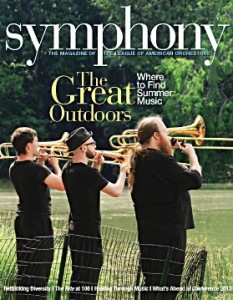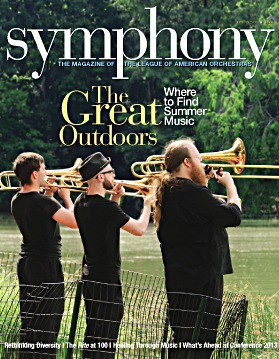Symphony Magazine, Spring 2013 Issue
 The spring issue of Symphony magazine is now available online. As usual, the magazine contains a variety of interesting articles.
The spring issue of Symphony magazine is now available online. As usual, the magazine contains a variety of interesting articles.
Chester Lane, Senior Editor at Symphony magazine, presents a fascinating article about the health and wellness programs springing up in orchestras. Many of these programs have been funded by the Ann and Gordon Getty Foundation (see my recent article about these grant awards). He features the Detroit Symphony’s participation in music therapy sessions at the Children’s Hospital of Michigan, the Longwood Symphony in Boston who partner with local medical non-profits, the Cincinnati Symphony’s partnership with the Mercy Health system, the Pittsburgh Symphony’s program with 30 musicians visiting Children’s Hospital and the veteran’s hospital, the Knoxville Symphony’s performances at the UT Medical Center, St. Louis Symphony’s SymphonyCares program where musicians perform at the St. Louis University Cancer Center, and the Portland (Maine) Symphony’s partnership with New England Rehabilitation Hospital. Chester describes the genesis of each program, often acknowledging the contribution of a specific musician, such as Penny Brill in Pittsburgh, Sylvia Samis in Cincinnati, and Sean Claire in Knoxville. This is a wonderful article, describing a growing initiative in many orchestras that is energizing the musicians who participate.
Robert Sandla, Symphony Editor in Chief, presents an overview of the upcoming League Conference in St. Louis from June 18-20. (Reminder that any musician who plays in a League orchestra can attend the conference for free.) The theme of this year’s Conference is “Imagining 2023,” with sessions designed to explore the experimentation and innovation that is occurring throughout the industry. The keynote speaker, Elizabeth Merritt, founding director of the Center for the Future of Museums, will explore the parallels for orchestras of how museums have transcended traditional boundaries to attract large numbers of patrons. Robert highlights a few sessions: the Orchestra Leadership Academy’s three-day “Basics of Collective Bargaining” seminar, presented in partnership with the Federal Mediation and Conciliation Service; Health and Wellness Programs: Learning from the Getty Orchestras; Building a Culture of Collaboration, exploring recent events with the St. Louis Symphony; “Check This Out” sessions, which are fast-paced TED-like presentations about new initiatives in many areas (audience development, outreach, artistic); and of course the many constituent sessions. The St. Louis Symphony will present a concert at Powell Hall, directed by David Roberson, and the youth orchestra will perform at the opening plenary session.
Jesse Rosen, President and CEO of the League, conducts an extensive interview with Bo Young Lee, Global Diversity and Inclusion Leader at Marsh, Inc., about diversity and inclusion in the symphony orchestra. Ms. Lee quotes Andrés Tapia to define these two terms: “diversity is the mix, and inclusion is making that mix work.” Their conversation is wide-ranging, touching on the historical nature of classical music as a Eurocentric art form, the nature of cultural bias and the role of “cultural competency,” the differences between unconscious, conscious and collective bias, and how to find community partners. Ms. Lee, who will be leading a session at the League’s Conference in June, advised that orchestras should “lean into the discomfort of the diversity conversation.”
Doug McLennon, editor of ArtsJournal.com, writes about the League’s Institutional Vision Program, which ended this year. He states that orchestras are fundamentally changing in response to larger forces, and thus there is a great need to train leaders who can cope with this change. The League’s Institutional Vision Program, founded in 2000, brought board members, musicians and administrators together to define missions and come up with strategies. Orchestras were chosen competitively, with each proposing a project and goal. The faculty included Tom Morris, former President of the Cleveland Orchestra, Lowell Noteboom, former President of the St. Paul Chamber Orchestra and League Board President, and David Nygren, chair of BoardSource and a governance consultant. 34 orchestras participated in the program and included very small to very large organizations. He concludes with case studies about the Adrian Symphony in Michigan, the San Diego Youth Orchestra, and the Florida Orchestra in Tampa/St. Petersburg.
Jennifer Melick, Managing Editor at Symphony magazine, writes about large-scale music events that bring orchestra musicians and their community together in novel ways. She features the Toronto Symphony’s performance of Tod Machover’s full-length work, the Cincinnati Symphony’s “One City, One Symphony,” and the Berlin Philharmonic’s performance of Lisa Bielawa’s Airfield Broadcasts in May, with a repeat by the San Francisco Symphony in October.
Music critic Don Rosenberg writes about the 100th anniversary of Stravinsky’s Rite of Spring — I recently wrote a blog post about his article.
Finally, Eileen Reynolds details the many, many summer festivals about to take place throughout the country.


No comments yet.
Add your comment